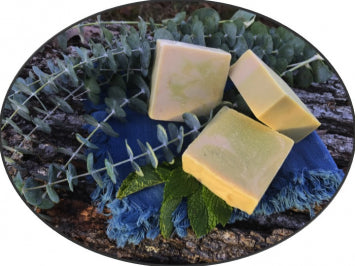
Smart Soap
Share
Honestly, I grew up with Ivory (so pure, it floats) Soap and never really thought about soaps one way or the other. When I was little, we understood “purity” – it caused a soap to float! Who’d-a-thunk floating might instead be because air had been pumped into the soap during its manufacturing process. What a gimmick!!! Did you know they brag about its purity’s causing it to float still today? Good grief!
When my kids came along, I bought tears-free shampoo, then soon forgot about soap ingredients. With four kids, I pretty much bought whatever was on sale! There wasn’t time to consider ingredients in products, just whether they performed and how much they cost.
But now I’m 67, my kids are grown, and I’ve learned the truth in John Muir’s words: “When we try to pick out anything by itself, we find it hitched to everything else in the universe.” Now I care about supporting the microbiota that live in my septic tank so they can perform for me. And I care about supporting the microbiota that live on my skin and on that of my grankids, so they can protect us from harmful organisms that exist everywhere around us.
When my son had micro-premie twins, suddenly every part of our environment became critical. Sanitation was part of our everyday rigor, and reasonably so. But it’s imperative that we discern what’s potentially harmful from what’s absolutely integral to natural healthy immune function.
Sandor Katz makes kraut and explains the bacteria’s working in that process. He asks us to consider the multitude of antibacterial soaps and other products in use everywhere today that supposedly "kill 99% of bacteria." He claims that probably only about one percent of bacteria around us is harmful, and he insists that our best defense against that one percent of harmful bacteria is the other 99% of beneficial bacteria that protects us against it!
I don’t know how much of that is accurate, but based on my experiences with diversity and with soil microbiota in general, it makes a lot of sense to me. I know that healthy plants are not bothered by fungi and disease, while weak plants languish. Why do you reckon this is? I know that a healthy immune system can manage all sorts of tribulation and it’s the microbiota in our guts that are in charge here.
Why on earth would I want to exterminate the tiny organisms that have kept me healthy all these 67 years? This understanding of the systems at work around and inside of us is why folks choose soaps made from ingredients that clean without killing.
Oil and lye combine in a beautiful alchemic dance called “saponification” wherein each gives up its own separate qualities and instead they become a new entity. Look it up. The result bubbles up and slides across your skin and removes what shouldn’t be there, without killing all of what needs to remain.
Even further, the Mayo Clinic reports that “plain soap and running water coupled with good technique are just as good against common childhood respiratory and stomach viruses and bacteria as antibacterial soap. [AND] Plain soap doesn’t induce the risk of creating resistant organisms!”
My family has been farming for a century now, and we are seeing amazing similarities in the way systems work, whether deep below ground, or deep inside our guts. Protecting what evolved to work properly and support/promote life is imperative.
We take too much for granted sometimes. Soap companies are not required by the FDA to list all of their ingredients, lest they give away “trade secrets.” Because of this, and because fragrances generally are made up of a multitude of chemicals, the Environmental Working Group considers the word “fragrance” on any label to actually equate to “hidden chemicals.” And the list of chemicals that are often toxic to many folks is too long to report here. Don’t even get the treehugger in me started on how much danger our toiletry products carry as they flow down our sinks and into our streams, wreaking havoc on the biodiversity in our rivers today.
Why bring unknown or antibacterial chemicals into your environment unnecessarily? Our friend is using the tallow from our grass-finished cattle and the lard from our pastured pigs to make a gentle soap for her babies, and we are enjoying the result of that chemical transformation between the lye and our animals’ fat, and seeing its strong but gentle and protective cleaning power.
One last kinda cool note: I don’t have citations to support this, but it’s my understanding that animal tallow contains the same lipids found in human fat, and supposedly prevents dryness at the cellular level, differently from the way petroleum-based lotions work.
We hope to offer a soap-making class in the upcoming year to share some wisdom and tallow and fun!!
